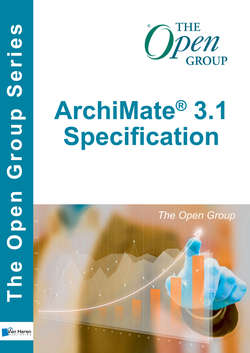Читать книгу ArchiMate® 3.1 Specification - The Open Group - Страница 7
На сайте Литреса книга снята с продажи.
List of Figures
ОглавлениеFigure 1: Top-Level Hierarchy of ArchiMate Concepts
Figure 2: ArchiMate Core Framework
Figure 3: ArchiMate Full Framework
Figure 4: Hierarchy of Behavior and Structure Elements
Figure 5: Behavior and Structure Elements Metamodel
Figure 6: Generic Internal Active Structure Element Notation
Figure 7: Generic External Active Structure Elements (Interface) Notation
Figure 8: Generic Internal Behavior Element Notation
Figure 9: Generic External Behavior Element (Service) Notation
Figure 10: Generic Event Notation
Figure 11: Generic Passive Structure Element Notation
Figure 12: Specializations of Core Elements
Figure 13: Generic Process Notation
Figure 14: Generic Function Notation
Figure 15: Generic Collaboration Notation
Figure 16: Generic Interaction Notation
Figure 17: Generic Motivation Element Notation
Figure 18: Composite Elements
Figure 19: Grouping Notation
Figure 20: Location Notation
Figure 21: Overview of Relationships
Figure 22: Composition Notation
Figure 23: Aggregation Notation
Figure 24: Assignment Notation
Figure 25: Realization Notation
Figure 26: Serving Notation
Figure 27: Access Notation
Figure 28: Influence Notation
Figure 29: Association Notation
Figure 30: Triggering Notation
Figure 31: Flow Notation
Figure 32: Specialization Notation
Figure 33: Junction Notation
Figure 34: Motivation Elements Metamodel
Figure 35: Stakeholder Notation
Figure 36: Driver Notation
Figure 37: Assessment Notation
Figure 38: Goal Notation
Figure 39: Outcome Notation
Figure 40: Principle Notation
Figure 41: Requirement Notation
Figure 42: Constraint Notation
Figure 43: Meaning Notation
Figure 44: Value Notation
Figure 45: Relationships Between Motivation Elements and Core Elements
Figure 46: Strategy Elements Metamodel
Figure 47: Resource Notation
Figure 48: Capability Notation
Figure 49: Value Stream Notation
Figure 50: Course of Action Notation
Figure 51: Relationships Between Strategy Elements and Motivation and Core Elements
Figure 52: Business Layer Metamodel
Figure 53: Business Internal Active Structure Elements
Figure 54: Business Actor Notation
Figure 55: Business Role Notation
Figure 56: Business Collaboration Notation
Figure 57: Business Interface Notation
Figure 58: Business Internal Behavior Elements
Figure 59: Business Process Notation
Figure 60: Business Function Notation
Figure 61: Business Interaction Notation
Figure 62: Business Event Notation
Figure 63: Business Service Notation
Figure 64: Business Passive Structure Elements
Figure 65: Business Object Notation
Figure 66: Contract Notation
Figure 67: Representation Notation
Figure 68: Product Metamodel
Figure 69: Product Notation
Figure 70: Application Layer Metamodel
Figure 71: Application Internal Active Structure Elements
Figure 72: Application Component Notation
Figure 73: Application Collaboration Notation
Figure 74: Application Interface Notation
Figure 75: Application Internal Behavior Elements
Figure 76: Application Function Notation
Figure 77: Application Interaction Notation
Figure 78: Application Process Notation
Figure 79: Application Event Notation
Figure 80: Application Service Notation
Figure 81: Data Object Notation
Figure 82: Technology Layer Metamodel
Figure 83: Technology Active Structure Elements
Figure 84: Node Notation
Figure 85: Device Notation
Figure 86: System Software Notation
Figure 87: Technology Collaboration Notation
Figure 88: Technology Interface Notation
Figure 89: Path Notation
Figure 90: Communication Network Notation
Figure 91: Technology Internal Behavior Elements
Figure 92: Technology Function Notation
Figure 93: Technology Process Notation
Figure 94: Technology Interaction Notation
Figure 95: Technology Event Notation
Figure 96: Technology Service Notation
Figure 97: Technology Passive Structure Elements
Figure 98: Artifact Notation
Figure 99: Physical Elements Metamodel
Figure 100: Equipment Notation
Figure 101: Facility Notation
Figure 102: Distribution Network Notation
Figure 103: Material Notation
Figure 104: Relationships Between Business Layer and Application and Technology Layer Elements
Figure 105: Relationships Between Application Layer and Technology Layer Elements
Figure 106: Implementation and Migration Metamodel
Figure 107: Work Package Notation
Figure 108: Deliverable Notation
Figure 109: Implementation Event Notation
Figure 110: Plateau Notation
Figure 111: Gap Notation
Figure 112: Relationships of Implementation and Migration Elements with Core Elements
Figure 113: Relationships of Implementation and Migration Elements with Motivation Elements
Figure 114: Conceptual Model of an Architecture Description (from [14])
Figure 115: Framing Stakeholder Concerns using the Viewpoint Mechanism
Figure 116: Correspondence Between the ArchiMate Language and the TOGAF ADM
